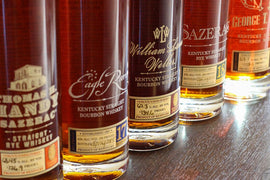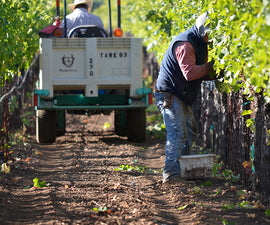This quarter we’re very excited to have our first private cask selection from Maker’s Mark distillery. Maker’s Mark was my gateway into the bourbon world, and I never anticipated myself coming back aboard the train at this stage in my bourbon evolution. That all changed after a trip in June to visit the distillery left me amazed at how they pursued their craft with such deep attention to detail and quality, all while delivering a consistent products.
The purpose of our trip was to create our own private cask selection. Unlike the typical cask selections where you are offered your choice of anywhere from three to thirty barrels at a time, this one allows you to choose from over 1000 combinations of different oak staves that you then add back to the barrel for a three month finishing period.
When I first heard of the program I was pretty skeptical of this process, as there seemed to be too many variables to control what the final outcome would be. I tried a handful of them before and hadn’t found one I liked. But the possibility of coming up with something really great intrigued me, and of we went to Kentucky.
While there our group tried probably twenty-five other private selections from retailers and bars across the country. I began taking pictures of the back label of every different one I tried, accompanied by some tasting notes. Most of the selections we found were similar, containing a dominant amount of ‘Baked American’ and ‘Seared French’ oak in the recipe. I found these to be too tannic and full of fresh oak for my taste. The rest of the ones fell somewhere on the opposite side of the spectrum with a large amount of ‘Roasted French’ and ‘Toasted French’ oak in their makeup. I liked these a little better, but they too contained lots of tannin or some tasted too much like coffee. This was going to be interesting...
The drive to Maker’s Mark distillery in Loretto, KY is bit further than the other distilleries if you are coming from Louisville. While in the car we strategized our approach and sipped on Maker’s Mark Japanese export bottles from years past. “We need to create something like that!” exclaimed my friend. So we saved some for the blending process to use as a benchmark. The property at the distillery was beautiful and picturesque, clearly capable of handling a lot of visitors on an annual basis. We took what was one of the most comprehensive distillery tours I have ever been on. This included a hike up to the very top of the still house – which happened to be closed down that day for repairs, though that didn’t stop it from still being 115 degrees up there. Other highlights included the yeast culture starter cooler (P.S. its fed by hopped beer!), the label room (they make all the labels on an antique letterpress) along with a final stop in the quality control lab. This turned out my absolute favorite part of the visit, where we blind tasted on groups of bourbons, each containing an outlier with a different ‘off’ flavor compound in them. After a much-needed lunch we headed to the barrel selection room for our blending experience.
We started off with an in-depth discussion on the influence of oak in bourbon and how different types of oak (French vs. American) produce different types of flavor compounds. This, along with the different cooking times and temperatures for the oak created a very different type of resulting whiskey. The object of the session was to choose a recipe combination of ten different oak staves that would be rested inside your barrel and left to mature for another three months. Each different type of oak stave gave off different flavor characteristics. ‘Baked American Oak’ was toasted low and slow in a convection oven; ‘Seared French Oak’ was toasted with infrared heat; ‘Maker’s 46 Oak’ was French oak that had been seared and infrared toasted; ‘Roasted French’ was cooked on high in a convection oven giving it a mocha like flavor; and ‘Toasted French’ which was a combo of high and low convection toasting. We first tasted regular Maker’s cask strength bourbon for a control group, then compared it to samples of the same bourbon that had been steeped in the each different oak stave.
All five of us in the group came up with a blend, and let it rest for before tasting. We then blindly tasted them, eliminating the ones we didn’t like off the bat. The one we did like we tried creating others that were similar but different in some way to explore what subtle adjustments would do to the resulting whiskey. After a few rounds of this the final favorite was still the recipe from the first group. We think we have a winner! We finished up by putting together our staves and dropping them into our barrel where it was sent away to rest for another three long and lonely months.
The name of the game at Maker’s Mark is consistency. When they decided to increase production, they doubled it exactly the same – same still, same everything. Cloning the process insured consistency. Why don’t they do a typical single barrel program? Because there isn’t a lot of difference between barrels due to rotation in the warehouse and all are bottled around five to six years old. And that’s why they developed the private select program. I left the distillery feeling light on my feet and excited, like I had seen the light or heard the gospel. I am excited to share it with you here. If you haven’t given makers a go in a while or better yet a visit, do it. You won’t regret it.
The Maker’s Mark PlumpJack ‘Private Selection’ is bottled at cask strength. Like all Maker’s Mark whiskey, it is what we call a ‘wheated bourbon’, as it does not contain any rye in the mash bill. All the barrels usually come out around the same proof level (consistency) and are vatted together before bottling or barreling for the ‘Private Select’ program.
The wheated bourbon notes are very apparent in the nose as there is not a trace of rye to be found. Lots of intense aromas of dark caramel, vanilla, mocha, toasted oak and lights hints of tobacco present themselves. A second inspection shows a deeper array of baking spices complimented by burnt orange peels and bitter chocolate. The palate confirms all these flavors with big bold intensity hitting the mid palate with a chunky chocolate caramel overtone that persists into a long full bodied finish that lingers with gentle heat and spice for a long time. Try pairing it with a steak, chocolate cake or your favorite robusto cigar like a Rocky Patel. Cheers!
Joshua Thinnes, Whisk(e)y Evangelist at PlumpJack Wine & Spirits
Find similar articles
American Whiskey ClubBourbonKentuckyMaker's MarkPrivate Barrel SelectionsWhiskey





